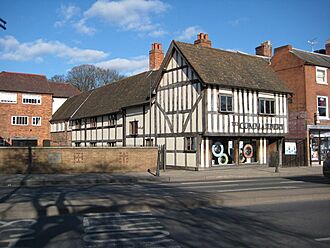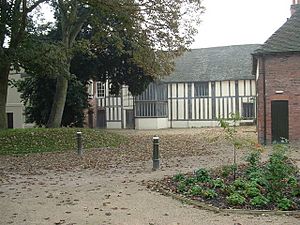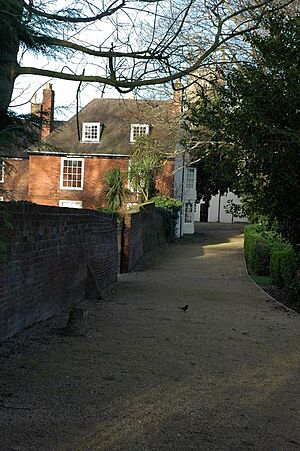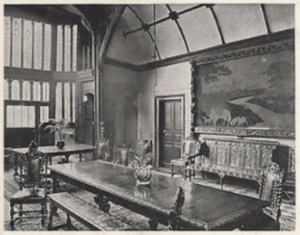The Commandery facts for kids
Quick facts for kids The Commandery |
|
|---|---|

The Commandery in March 2010
|
|
| Former names | Hospital of St. Wulfstan |
| General information | |
| Location | Worcester, Worcestershire, England |
| Coordinates | 52°11′16″N 2°13′00″W / 52.187903°N 2.216755°W |
| Construction started |
|
| Completed |
|
| Opened |
|
| Renovated |
|
| Demolished |
|
| Owner | Worcester City Council |
| Technical details | |
| Structural system | Timber framing |
| Floor count | 2 |
The Commandery is a super old building in Worcester, England, that you can visit today! It first opened as a museum in 1977. For a while, it was the only museum in England focused just on the Civil Wars.
In May 2007, The Commandery reopened after a big makeover. It's now owned by the Worcester City Council and is a special Grade I listed building, meaning it's very important historically.
Contents
The Commandery's Long Story
Early Days: A Hospital for Those in Need
The very first building on this spot was the Hospital of St. Wulfstan. It was built around 1085 by Bishop Wulfstan (who later became a saint!). This hospital was like a hospice today, a place for people who were very sick, poor, or traveling pilgrims. It was built near the Chapel of St. Gudwal, which had been there since the 950s.
The hospital's name probably changed in the early 1200s to honor St. Wulfstan after he became a saint in 1203. We know about the hospital from old stories written in 1240. One story tells of a man named Thomas who was cared for there and made a surprising recovery. This shows the hospital was definitely open by 1221.
The first known leader of the hospital was Walter de Wredens. He had fought in the Crusades before coming to the hospital. He led the hospital until he passed away around 1290. Records from 1294 show that 22 sick people were being cared for at the hospital.
By the late 1300s, the hospital started doing something different. It began offering people a place to live and food for life in exchange for their property. This was a bit like buying a lifetime membership. By the 1400s, the Hospital of St. Wulfstan had become more of a business than just a charity.
In 1441, the Bishop of Worcester, Bishop Bourchier, decided this wasn't right. He changed the rules, stopping the practice of trading property for care. He made the hospital go back to its original purpose: giving bread to the poor and caring for sick patients. He also set up a new team to run it, including a master, chaplains, and sisters. This system stayed until the hospital closed in 1540.
The Hospital of St. Wulfstan was rebuilt between 1460 and 1470. The amazing roof of the great hall that you can see today was built in 1491. Some rooms from this time include a "painted chamber" with pictures of Catholic saints. People think this room might have been a special place for sick people to pray, with the paintings showing them what life after death might be like.
Changes in the 16th Century

In 1539, Richard Morysyne bought the Hospital of St. Wulfstan and the Chapel of St. Gudwal. In 1540, Henry VIII closed down the hospital as part of the Dissolution of the Monasteries. This meant many religious buildings across England were shut down. The hospital building became a home, and the chapel was left to fall apart.
It's thought that Richard Morysyne was put in charge specifically to close down the hospital. What happened next is a bit of a mystery. Some believe he made a lot of money by buying the hospital for a very low price. Others think he gave it to the King, who then gave it to Christ Church, Oxford.
Around this time, the beautiful wall paintings in the "painted chamber" were covered up with whitewash. Many other old and valuable religious items were probably lost too.
In 1541, the Commandery was rented out to Thomas Wylde, a rich cloth merchant from Worcester. By 1545, Thomas bought the building completely. He added a fancy fireplace mantel with his family's crest around 1594.
The Civil War and Later Changes
During the English Civil War, the Wylde family who owned The Commandery supported King Charles I and later King Charles II. In 1651, The Commandery became the headquarters for the King's army during the Battle of Worcester. An old hill nearby, which had been used for defense before, was made stronger and is now known as Fort Royal Hill.
The battle ended with a victory for the Roundheads (the King's opponents). King Charles II had to escape, and a leader named William Hamilton died at The Commandery on September 12, 1651. He was exhausted and refused to have his injured leg treated by a Roundhead doctor.
It's believed that the last parts of the Chapel of St. Gudwal were taken down in the 1700s. The eastern side of The Commandery was built in 1708. In 1764, Thomas Wylde sold The Commandery to John Dandridge, a lawyer. Before 1791, the Dandridge family added more parts to the eastern side of the building, including a noticeable house at the northeast corner.
In 1786, John Adams and Thomas Jefferson, who later became Presidents of the United States, visited The Commandery. They wanted to see the English city where "the battle for freedom" had happened.
From the 19th Century to Today
In the mid-1800s, Richard Mugg-Mence bought The Commandery. He made some changes, including removing parts of the great hall. In 1843, he also tore down a three-story house next to The Commandery.
Between 1866 and 1887, The Commandery was rented out and became the Worcester College for Blind Sons of Gentlemen. The first headmaster, Reverend Robert Hugh Blair, believed that blind boys should get a good education and be able to have professional jobs. His successor, Reverend Samual Strong Forster, even planned to open a similar school for blind girls.
In 1888, Joseph Littlebury bought The Commandery. He turned it into a printworks called Littlebury & Company. They printed newspapers, magazines, and town guides. The Littlebury family lived in one part of the building, while the printworks was in another. In 1935, a decorator rediscovered the old wall paintings in the "painted chamber" when removing whitewash!
The Commandery became a Grade I listed building on April 5, 1971. Littlebury & Company continued until 1973 when the owner retired. The building was then sold to the Worcester City Council.
The Commandery opened as a museum on June 13, 1977, telling the story of the building itself. By 1985, it needed a lot of repair because it was unsafe. Parts of the great hall were fixed in 1987, and outside repairs started in 1988.
Between 2004 and 2006, archaeologists dug up parts of The Commandery. They found the exact spot of the Chapel of St. Gudwal in 2006 and even discovered two buried skeletons from two years before. The Commandery was restored again in 2006 and reopened to the public in May 2007.
What's in a Name? "The Commandery"
The name "Commandery" is thought to be linked to the Knights of the Crusades. An old historian named Nash (in 1784) guessed that Walter de Wredens, the first leader of the Hospital of St. Wulfstan, had fought in the Crusades. He might have been a "Commander" with the Knights Templar or Knights Hospitaler.
Nash thought that Walter kept using his military title of Commander until he died around 1290. Then, the next leaders of the hospital also started using the title. So, the place where the Commander lived became known as The Commandery. No one has found a better explanation for the name since then!




